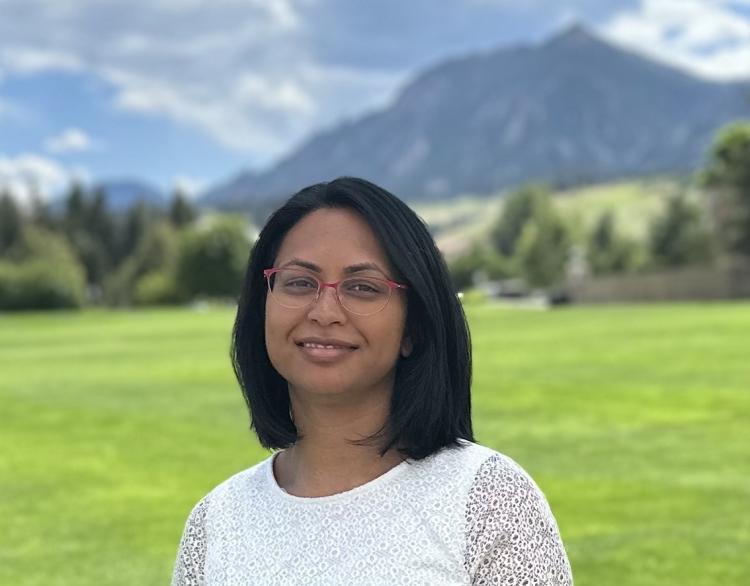It’s widely recognized that reducing lawn irrigation is essential for water conservation, particularly in water-scarce regions like the western United States. Aditi Bhaskar is studying a lesser-known consequence of irrigation efficiency: the potential reduction in streamflow, which could have implications for urban stream health, recreation and downstream users.
“Downstream areas in the South Platte River, (which flows through Colorado), have agricultural users with senior water rights,” Bhaskar said. “Understanding how these conservation efforts affect the flow downstream is crucial.”
Bhaskar’s research is supported by her National Science Foundation CAREER award, granted in 2021 during her tenure at Colorado State University and since transferred to CU Boulder. She joined CU Boulder’s Department of Civil, Environmental and Architectural Engineering as an associate professor in January 2023.
Bhaskar studies the impact of urban development on water resources, and the goal of her CAREER award is to gain a comprehensive understanding of the relationship between urban conservation and streamflow in the Denver-metro area. Her research utilizes a variety of approaches including monitoring current conditions and modeling landscape transformations.
Bhaskar and her team are particularly interested in the impact of reduced outdoor water use on stream flow because the Colorado Water Plan focuses on changing how residents use water outdoors to bridge the projected water supply-demand gap.
The research is closely integrated with an educational initiative aimed at promoting diversity in Colorado’s urban water workforce.
CU Boulder sat down with Bhaskar to learn more about the project.
 What interests you most about this topic?
What interests you most about this topic?
Most irrigation systems are programmed based on a set number of days per week, regardless of the weather. We want to explore the impact of conservation practices such as those that utilize soil-moisture based irrigation systems. The systems detect soil moisture levels and water accordingly. These systems are not widely used, but they offer a potential technology for more efficient irrigation and water conservation.
We are also exploring landscape changes – particularly with the state’s approval of funding for turf grass replacement programs. Under that program, individuals can replace their lawns with lower water-use landscapes, such as xeric grasses and plants, or alternative materials like mulch, rock and artificial turf.
We’re also interested in alternative water supply conservation strategies, such as harvesting rainwater for outdoor irrigation.
What are you currently working on?
We recently published a paper that focused on our 2019 data concerning naturally occurring water stable isotopes. We completed sampling in 2021 and 2022 and we’re now analyzing the data. We’re utilizing the distinct isotopic signatures from high elevation source watersheds and locally derived sources at lower elevations to determine the water’s origin. One of the next steps involves using modeling techniques to explore how lawn irrigation return flows might change under different types of water-wise landscaping practices.
Another monitoring approach focuses on tracking stream flow in a rangeland watershed located south of Denver in Parker, Colorado. This stream rarely flows. Later this year, the watershed will undergo development designed to preserve the stream network. We are interested in monitoring this stream throughout the development process. We have three years of predevelopment data during which the stream flowed once. We anticipate that as people begin irrigating their lawns, the streams will flow all summer, allowing us insights into temporal patterns and connections between base flow and the watershed’s development.
Which education components of your recent NSF CAREER award are you most excited about?
We have several different programs. One is at Colorado State University, and my goal is to bring it to CU Boulder. It provides fellowship support to a cohort of juniors and seniors from diverse backgrounds who are interested in pursuing water-related careers. It also offers them networking opportunities, including interacting with water professionals, participation in conferences and access to professional development and research opportunities.
Another aspect involves collaboration with my CSU partners. They received a grant focused on incorporating equity into engineering education across disciplines and content. The objective is to integrate the social context of engineering into technical classes, enabling engineers to recognize the societal implications of their designs.
Our aim with that project is to understand and share best practices with educators teaching water-related subjects, which are closely connected to societal concerns and social contexts.
Can you give an example of what factors the students might take into account and what that looks like in an education setting?
In Denver and many other cities impervious surface cover is related to race. Wealthier white neighborhoods tend to have more tree cover, lower population density, larger lot sizes and a high prevalence of single-family homes. The presence of impervious surfaces contributes to issues such as increased flooding and urban heat islands. Wealthier neighborhoods are cooler in the summer. We see these things in research, and we are beginning to integrate them into education practices.
In another course, students explore water quality violations in the U.S. and how they are disproportionately distributed based on race and income. Students analyze data, interpret graphs and gain understanding of journal articles. They delve into the root causes of these disparities and reflect on their role as water resource or environmental engineers in either contributing or mitigating these issues. Combining data analysis and calculations has been successful in helping students grasp these concepts. They recognize the connection between what they are learning about water resources and the broader social context.

